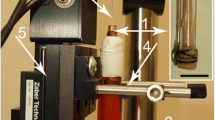Abstract
Endovenous laser ablation is an effective and minimally invasive alternative to surgical removal of incompetent veins. However, many controversies concerning optimal laser parameters usage in this procedure still remain. The purpose of this experimental study was to assess the adequate parameters required for vein wall destruction and to evaluate the role of fiber pullback velocity on vessel wall degradation. Varicose vein segments were treated with 1470-nm diode laser 3 to 9.5 W in power. The fiber moved through the vein at a velocity of 0.7 or 1.5 mm/s; the applied linear endovenous energy density (LEED) was 40–95 J/cm. The temperature of the vein surface in the course of laser irradiation was controlled by IR thermography. The intact collagen in treated vein specimens was studied by differential scanning calorimetry. The increase in the surface temperature with applied energy was found to be about three times slower for the pullback velocity of 0.7 mm/s than that of 1.5 mm/s. The collagen in the tissue was totally denatured in the case of the surface temperature of about 91 °C. The critical values of LEED ensured complete degradation of vein wall were of 53 and 71.5 J/cm for velocities of 1.5 and 0.7 mm/s, respectively. Our experimental study supports the conception that it is laser power and pullback velocity rather than LEED value that determine the temperature as well the collagen framework degradation and therefore the thermal response of procedure.







Similar content being viewed by others

References
Mordon SR, Vuylsteke ME (2011) Varicose veins: endovenous laser treatment. In: Raulin C, Karsai S (eds) Laser and IPL technology in dermatology and aesthetic medicine. Springer-Verlag, Berlin, pp 211–224
Fan C-M, Rox-Anderson R (2008) Endovenous laser ablation: mechanism of action. Phlebology 23:206–213. doi:10.1258/phleb.2008.008049
Malskat WS, Poluektova AA, van der Geld CW, Neumann HA, Weiss RA, Bruijninckx CM, van Gemert MJ (2014) Endovenous laser ablation (EVLA): a review of mechanisms, modeling outcomes, and issues for debate. Lasers Med Sci 29:393–403. doi:10.1007/s10103-013-1480-5
Poluektova AA, Malskat WS, van Gemert MJ, Vuylsteke ME, Bruijninckx CM, Neumann HA, van der Geld CW (2014) Some controversies in endovenous laser ablation of varicose veins addressed by optical-thermal mathematical modeling. Lasers Med Sci 29:441–452. doi:10.1007/s10103-013-1450-y
Neumann HA, van Gemert MJ (2014) Ins and outs of endovenous laser ablation: afterthoughts. Lasers Med Sci 29:513–518. doi:10.1007/s10103-013-1499-7
Wieliczka DM, S. Weng S, Querry MR (1989) Wedge shaped cell for highly absorbent liquids: infrared optical constants of water. Appl Opt 28:1714–1719. doi:10.1364/AO.28.001714
Miles CA, Wardale RJ, Birch HL, Bailey AJ (1994) Differential scanning calorimetric studies of superficial digital flexor tendon degeneration in the horse. Equine Vet J 26:291–296. doi:10.1111/j.2042-3306.1994.tb04389.x
McClain PE, Wiley ER (1972) Differential scanning calorimeter studies of the thermal transitions of collagen: implication on structure and stability. J Biol Chem 247:692–697
Goissis G, Suzigan S, Parreira DR, Maniglia JV, Braile DM, Raymundo S (2000) Preparation and characterization of collagen-elastin matrices from blood vessels intended as small diameter vascular grafts. Artif Organs 24:217–223. doi:10.1046/j.1525-1594.2000.06537.x
Ignat’eva NY, Zakharkina OL, Lunin VV, Sergeeva EA, Mazaishvili KV, Maksimov SV (2013) Effect of venous wall immobilization on the thermal degradation of collagen. Russ J Phys Chem A 87:1929–1934. doi:10.7868/S0044453713110125
Chen SS, Wright NT, Humphrey JD (1998) Heat-induced changes in the mechanics of a collagenous tissue: isothermal, isotonic shrinkage. J Biomech Eng 120:382–388. doi:10.1115/1.2798005
Wells PB, Thomsen S, Jones MA, Baek S, Humphrey JD (2005) Histological evidence for the role of mechanical stress in modulating thermal denaturation of collagen. Biomech Model Mechanobiol 4:201–210. doi:10.1007/s10237-005-0002-1
Welch AJ, van Gemert MJC (eds.) (2011) Optical-thermal response of laser-irradiated tissue, 2nd edn. Springer, Netherlands doi:10.1007/978-90-481-8831-4
Niemz MH (2004) Laser-tissue interactions fundamentals and applications, 3rd edn. Springer, Berlin
Nozoe S, Honda N, Ishii K, Awazu K (2011) Quantitative analysis of endovenous laser ablation based on human vein optical properties. Proc SPIE 8092:80921J. doi:10.1117/12.889161
Aksan A, McGrath JJ, Nielubowicz DS (2005) Thermal damage prediction for collagenous tissues. Part I: A clinically relevant numerical simulation incorporating heating rate dependent denaturation. J Biomech Eng 127:85–97. doi:10.1115/1.1835355
Beck TJ, Burgmeier C, Blagova R, Steckmeier B, Hecht V, Schmedt C-G, Sroka R (2007) Thermal-induced effects on vein tissue—a basic ex-vivo investigation for EVLT. Med Las Appl 22:238–241. doi:10.1016/j.mla.2007.10.003
Disselhoff BC, Rem AI, Verdaasdonk RM, Kinderen DJ, Moll FL (2008) Endovenous laser ablation: an experimental study on the mechanism of action. Phlebology 23:69–76. doi:10.1258/phleb.2007.007038
Porto LC, da Silveira PR, de Carvalho JJ, Panico MD (1995) Connective tissue accumulation in the muscle layer in normal and varicose saphenous veins. Angiology 46:243–249. doi:10.1177/000331979504600308
Acknowledgements
This work was supported by the Russian Foundation for Basic Research (grant no. 16-02-00236a) and by the Russian Science Foundation (grant no. 14-13-01422).
Author information
Authors and Affiliations
Corresponding author
Ethics declarations
Conflict of interest
The authors declare that they have no conflict of interest.
Rights and permissions
About this article
Cite this article
Ignatieva, N.Y., Zakharkina, O.L., Masayshvili, C.V. et al. The role of laser power and pullback velocity in the endovenous laser ablation efficacy: an experimental study. Lasers Med Sci 32, 1105–1110 (2017). https://doi.org/10.1007/s10103-017-2214-x
Received:
Accepted:
Published:
Issue Date:
DOI: https://doi.org/10.1007/s10103-017-2214-x



